RBT Measurement Quiz
Measurement in Applied Behavior Analysis (ABA) is the systematic method of observing and recording behavior. It allows behavior analysts to quantify progress, track interventions, and make data-driven decisions.
💡Definition:
Measurement in ABA refers to the process of collecting objective data on behavior to guide treatment decisions and track client progress.
Measurement is essential for the RBT role, as accurate data collection ensures that interventions are effective, ethical, and evidence-based.
🧩 Types of Measurement
1. Continuous Measurement
Continuous measurement records every instance of a behavior during observation. Common types include:
- Frequency/Rate: How many times a behavior occurs
- Duration: How long a behavior lasts
- Latency: Time between a stimulus and behavior start
- Interresponse Time (IRT): Time between consecutive behaviors
✅ Continuous measurement is used when behaviors are frequent, observable, and discrete.
2. Discontinuous Measurement
Discontinuous measurement samples behavior instead of recording every occurrence. Common types include:
- Partial Interval Recording: Notes if behavior occurs at any point in an interval
- Whole Interval Recording: Notes if behavior occurs for the entire interval
- Momentary Time Sampling: Notes if behavior occurs at the end of a time interval
⚠️ Discontinuous methods are approximations, often used when full observation is impractical.
3. Permanent Product Recording
Permanent products measure tangible outcomes of behavior rather than the behavior itself. Examples:
- Worksheets completed
- Number of toys organized
- Meals prepared
📌 This is especially useful for behaviors that produce lasting evidence.
⚖️ Importance of Accurate Measurement
Accurate measurement ensures:
- Data-driven decisions: Clinicians can adapt treatment based on real outcomes
- Client safety: Misrecorded data can lead to ineffective or harmful interventions
- Ethical compliance: RBTs follow BACB guidelines for honest reporting
- Progress tracking: Objective data shows whether interventions are effective
💡 Tip for RBTs: Always double-check data and maintain Interobserver Agreement (IOA) for reliability.
🧠 Choosing the Right Measurement System
When deciding which measurement method to use, consider:
- Behavior type: Is it discrete or continuous?
- Observation feasibility: Can you watch the behavior every time it occurs?
- Accuracy requirement: Does the behavior require precise timing or frequency?
- Data analysis: Will you use the data to calculate rate, duration, or trends?
✅ Example: Frequency recording is best for hand-raising, while duration recording is ideal for tantrums.
📝 Tips for Effective Measurement
- Use consistent timing devices (stopwatch, timer, software)
- Record data immediately to avoid memory bias
- Label data clearly with client, date, behavior, and session
- Check IOA at least once per week to maintain accuracy
- Understand ethical implications — falsifying or guessing data is a BACB violation
🧩 Common Challenges in Measurement
- High-frequency behaviors: Hard to count every instance
- Short-duration behaviors: May be missed if timing is off
- Multiple simultaneous behaviors: May require two observers
- Observer fatigue: Leads to inaccurate or inconsistent recording
✅ Solution: Use discontinuous measurement or permanent product recording when continuous measurement is impractical.
Top-Rated RBT Practice Exams to Boost Your Exam Success
Achieve your goal to pass the RBT exam with our expertly designed mock tests and study tools.
